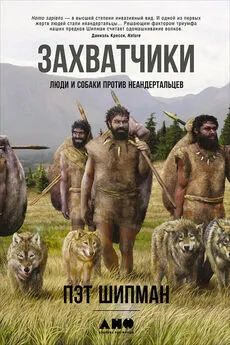Пэт Шипман - Захватчики: Люди и собаки против неандертальцев
- Название:Захватчики: Люди и собаки против неандертальцев
- Автор:
- Жанр:
- Издательство:Литагент Альпина
- Год:2016
- Город:Москва
- ISBN:978-5-9614-4412-4
- Рейтинг:
- Избранное:Добавить в избранное
-
Отзывы:
-
Ваша оценка:
Пэт Шипман - Захватчики: Люди и собаки против неандертальцев краткое содержание
В этой книге собраны убедительные доказательства того, что основным фактором гибели неандертальцев была прямая конкуренция с пришедшим на ту же территорию современным человеком. Опираясь на инвазивную биологию, которая говорит, что, чем вид ближе к инвазивным хищникам, с тем большей конкуренцией он столкнется, Пэт Шипман отслеживает разрушительное воздействие растущей популяции человека современного типа: сокращение ареала неандертальца, деление его популяции на небольшие группы и утрату генетического разнообразия данного вида.
Но не только современные люди конкурировали с неандертальцами. Шипман рассказывает о потрясающем партнерстве человека с первыми одомашненными волками-собаками, появление которых совпало с началом исчезновения неандертальцев. Автор выдвинула гипотезу, что союз двух хищников – человека и волка – позволил успешно охотиться на крупных млекопитающих ледникового периода, что дало решающее преимущество над неандертальцами, когда изменение климата сильно осложнило жизнь обеих групп рода Homo.
Захватчики: Люди и собаки против неандертальцев - читать онлайн бесплатно ознакомительный отрывок
Интервал:
Закладка:
S. Churchill, R. Franciscus, H. McKean-Peraza et al., «Shanidar 3 Neandertal Rib Puncture Wound and Paleolithic Weaponry», Journal of Human Evolution 57 (2009): 163–178, doi: 10.1016/j. jhevol. 2009.05.010.
134
F. Ramirez Rozzi, F. d'Errico, M. Vanhaeren et al., «Cutmarked Human Remains Bearing Neandertal Features and Modern Human Remains Associated with the Aurignacian at Les Rois,» Journal of Anthropological Science 87 (2009): 153–185.
135
C. Finlayson, The Human Who Went Extinct; Why Neanderthals Died Out and We Survived (New York: Oxford University Press, 2009), 118–119.
136
Froehle and Churchill, «Energetic Competition between Neandertals and Anatomically Modern Humans»; L. Aiello and P. Wheeler, 2003. «Neanderthal Thermoregulation and the Glacial Climate,» in Neanderthals and Modern Humans in the European Landscape during the Last Glaciation, eds. T. van Andel and W. Davies (Cambridge: McDonald Institute for Archaeological Research, University of Cambridge, 2003), 147–166; S. Churchill, «Bioenergetic Perspectives on Neandertal Thermoregulatory and Activity Budgets,» in Neanderthals Revisited: New Approaches and Perspectives, eds. K. Harvatiand T. Harrison (Dordrecht: Springer, 2006), 113–131; M. Sorensen and W. Leonard, «Neanderthal Energetics and Foraging Efficiency,» Journal of Human Evolution 40 (2001): 483–495; A. Steegmann, F. Cerny, and T. Holliday, «Neandertal Cold Adaptation: Physiological and Energetic Factors,» American Journal of Human Biology 14 (2002): 566–583.
137
Sorensen, Leonard, «Neanderthal Energetics and Foraging Efficiency»; Steegmann et al., «Neandertal Cold Adaptation.»
138
Aiello, Wheeler, «Neanderthal Thermoregulation.»
139
J. Gittleman, S. Thompson, «Energy Allocation in Mammalian Reproduction,» American Zoologist 28 (1988): 863–875.
140
B. Hockett, «The Consequences of Middle Paleolithic Diets on Pregnant Neanderthal Women,» Quaternary International 264 (2012): 78–82, p. 79.
141
B. Hockett, «The Consequences of Middle Paleolithic Diets on Pregnant Neanderthal Women,» Quaternary International 264 (2012): 78–82, p. 81.
142
T. Holliday, «Postcranial Evidence of Cold Adaptation in European Neandertals,» American Journal of Physical Anthropology 104 (1997): 245–258.
143
C. Carbone, J. Gittelman, «A Common Rule for the Scaling of Carnivore Density,» Science 295 (2002): 2273–2276.
144
См. прекрасный обзор S. E. Churchill, Thin on the Ground (New York: Basic Books, 2014).
145
C. Hertler and R. Volmer, «Assessing Prey Competition in Fossil Carnivore Communities – A Scenario for Prey Competition and Its Evolutionary Consequences for Tigers in Pleistocene Java,» Palaeogeography, Palaeoclimatology, Palaeoecology 257 (2008): 67–80; H. Hemmer, O. Owen-Smith, and M. Mills, «Predator-Prey Size Relationships in an African Large-Mammal Food Web,» Journal of Animal Ecology 77 (2008): 173–183, doi: 10.1111/j.l365–2656.2007.01314.x.
146
S. Miinzel, M. Stiller, M. Hofreiter et al., «Pleistocene Bears in the Swabian Jura (Germany): Genetic Replacement, Ecological Displacement, Extinctions and Survival,» Quaternary International 245 (2011): 225–237.
147
A. Turner and M. Anton, The Big Cats and Their Fossil Relatives: An Illustrated Guide to Their Evolution and Natural History (New York: Columbia University Press, 1997); W. Anyonge, «Body Mass in Large Extant and Extinct Carnivores,» Journal of Zoology London 231 (1993): 339–350.
148
R. Guthrie, Frozen Fauna of the Mammoth Steppe (Chicago: University of Chicago Press, 1990).
149
Turner, Anton. Big Cats.
150
Anyonge, «Body Mass in Large Extant and Extinct Carnivores.»
151
Churchill, Thin on the Ground, ch. 8.
152
Hemmer et al., «Predator-Prey Size Relationships.»
153
Данные из работы D. Brook and D. Bowman, «The Uncertain Blitzkrieg of Pleistocene Megarauna,» Journal of Btogeography 31 (2004): 517–523.
154
C. Carbone, G. Mace, S. C. Roberts et al., «Energetic Constraints on the Diet of Terrestrial Carnivores,» Nature 402 (1999): 287, doi: 10.1038/46266.
155
Hertler and Volmer, «Assessing Prey Competition.»
156
Churchill, Thin on the Ground, 271–273.
157
D. Stanford, R. Bonnichsen, and R. Morlan, «The Ginsberg Experiment: Modern and Prehistoric Evidence of a Bone-Flaking Technology,» Science 212 (1981): 438–440, doi: 10.1126/science. 212.4493.438.
158
D. Grayson and F. Delpech, «Tie Large Mammals of Roc de Combe (Lot, France): The Chatelperronian and Aurignacian Assemblages,» Journal of Anthropological Archaeology 27 (2008): 359.
159
H. Bocherens, D. Drucker, D. Bonjean et al., «Isotopic Evidence for Dietary Ecology of Cave Lion (Panthera spelaea) in North-Western Europe: Prey Choice, Competition and Implications for Extinction,» Quaternary International 245 (2011): 249–261.
160
Churchill, Thin on the Ground, 264–276.
161
N. Carter, B. Shrestha, J. Karki, N. Pradhan et al., «Coexistence between Wildlife and Humans at Fine Spatial Scales,» Proceedings of the National Academy of Sciences USA 109 (2012): 15360–15365.
162
E. Ghezzo, A. Palchetti, and L. Rook, «Recovering Data from Historical Collections: Stratigraphic and Spatial Reconstruction of the Outstanding Carnivoran Record from the Late Pleistocene Equi Cave (Apuane Alps, Italy),» Quaternary Science Reviews 96 (2014): 168–179.
163
C. Diedrich, «Late Pleistocene Leopards across Europe: Northernmost European German Population, Highest Elevated Records in the Swiss Alps, Complete Skeletons in the Bosnia Herzegowina Dinarids and Comparison to the Ice Age Cave Art,» Quaternary Science Reviews 76 (2013): 167–193; G. von Petzinger and A. Nowell, «A Place in Time: Situating Chauvet within the Long Chronology of Symbolic Behavioral Development,» Journal of Human Evolution, in press, doi: 10.1016/j.jhevol. 2014.02.022.
164
Münzel et al., «Pleistocene Bears in the Swabian Jura.»
165
Münzel et al., «Pleistocene Bears in the Swabian Jura.», с. 231.
166
«True Causes for Extinction of Cave Bear Revealed: More Human Expansion than Climate Change,» Science News, August 25, 2010.
167
M. Stiller, G. Baryshnikov, H. Bocherens et al., «Withering Away – 25,000 Years of Genetic Decline Preceded Cave Bear Extinction,» Molecular Biology and Evolution 27 (2010): 975–978.
168
Mellars and French, «Tenfold Population Increase.»
169
Münzel et al., «Pleistocene Bears in the Swabian Jura,» 232–233.
170
Froehle and Churchill, «Energetic Competition between Neandertals and Anatomically Modern Humans.»
171
P. Wojtal, J. Wilczyński, Z. Bocheński et al., «Tie Scene of Spectacular Feasts: Animal Remains from Pavlov I South-east, Czech Republic,» Quaternary International 252 (2012): 122–141.
172
S. Kuhn and M. C. Stiner, «What's a Mother to Do? Tie Division of Labor among Neandertals and Modern Humans in Eurasia,» Current Anthropology 47 (2006): 953–980.
173
G. Haynes, Mammoths, Mastodonts, and Elephants: Biology, Behavior, and the Fossil Record (Cambridge: Cambridge University Press, 1991).
174
E. Wing and A. Brown, Paleonutrition (New York: Academic Press, 1979).
175
Hortolá and Martínez-Navarro, «Quaternary Megafaunal Extinction and the Fate of Neanderthals.»
176
K. Richards and M. Jagger, «You Can't Always Get What You Want.» Let It Bleed, ABKCO Records, 2002.
177
Mellars and French, «Tenfold Population Increase.»
178
N. Conard, «The Cultural Niche»; N. Conard, M. Bolus, P. Goldberg et al., «The Last Neanderthals and the First Modern Humans in the Swabian Jura,» in When Neanderthals and Modern Humans Met, ed. N. Conard (Tubingen: Kerns Verlag, 2006), 305–342.
179
Данные о плотности распределения взяты из работ Haynes, Mammoths, Mastodonts, and Elephants; G. Haynes, «Mammoth Landscapes: Good Country for Hunter-Gatherers,» Quaternary International 142/143 (2006): 20–29; F. De Boer, F. van Langevelde, H. Prins et al., «Understanding Spatial Differences in African Elephant Densities and Occurrence, a Continent-Wide Analysis,» Biological Conservation 159 (2013): 468–476; IUCN African Elephant Specialist Group, www.elephantdatabase.org.
180
Wilczyriski et al., «Spatial Organization of the Gravettian Mammoth Hunters' Site,» 3638.
181
L. Demay, S. Pean, and M. Patou-Mathis, «Mammoths used as food and building resources by Neanderthals: Zooarchaeological study applied to layer 4, Molodova I (Ukraine),» Quaternary International 276/277 (2012): 212–226.
182
R. H. Gargett, «One Mammoth Steppe Too Far,» Subversive Archaeologist (blog), December 21, 2011, http://www.thesubversivearchaeologist.com/2011/12/one-mammoth-steppe-too-far.html.
183
Higham et al., «The Timing and Spatio-Temporal Patterning.»
184
H. Bocherens and D. Drucker, «Dietary Competition between Neanderthals and Modern Humans: Insights from Stable Isotopes,» in When Neanderthals and Modern Humans Met, ed. N. Conard (Tubingen: Kerns Verlag, 2006), 129–143; Germonpre et al., «Possible Evidence of Mammoth Hunting»; P. Semal, H. Rougier, I. Crevecoeur et al., «New Data on the Late Neandertals: Direct Dating of the Belgian Spy Fossils,» American Journal of Physical Anthropology 138 (2009): 421–428.
185
N. McDermott, «Did Climate Change Drive the Woolly Mammoth to Extinction? Genetic Tests Reveal Species Declined as Weather Warmed,» Daily Mail, September 11, 2013.
186
M. Germonpre, M. Sablin, R. E. Stevens et al., «Fossil Dogs and Wolves from Palaeolithic Sites in Belgium, the Ukraine and Russia: Osteometry, Ancient DNA and Stable Isotopes,» Journal of Archaeological Science 36 (2009): 473–490.
187
M. Germonpre, M. Laznickova-Galetova, and M. Sablin, «Palaeolithic Dog Skulls at the Gravettian Predmosti Site, the Czech Republic,» Journal of Archaeological Science 39 (2012): 184–202.
188
M. Germonpré, J. Ràikônnen, M. Lâznickovâ-Galetovâ et al., «Mandibles from Palaeolithic Dogs and Pleistocene Wolves at Predmosti, the Czech Republic,» in The World of Gravettian Hunters, ed. P. Wojtal, Institute of Systematics and the Evolution of Animals, Polish Academy of Sciences (2013), 23–24; M. Germonpré, M. Lâznickovâ-Galetovâ, R. Losey et al., «Large Canids at the Gravettian Predmosti site, the Czech Republic: The Mandible,» Quaternary International (in press): 1–19.
Читать дальшеИнтервал:
Закладка:



![Марта Стаут - Социопат по соседству [Люди без совести против нас. Как распознать и противостоять] [litres]](/books/1060204/marta-staut-sociopat-po-sosedstvu-lyudi-bez-sovest.webp)






